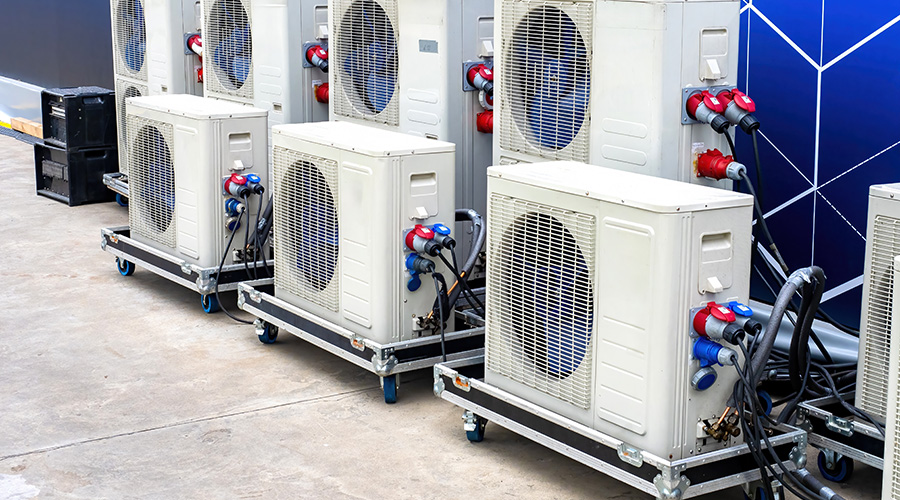The Maintenance-Energy Efficiency Link
Motors use a large part of the energy used daily in institutional and commercial facilities, but in many cases, motors operate inefficiently. A comprehensive, up-to-date motor inspection and repair program can go a long way in helping motors deliver the reliability and efficiency that institutional and commercial facilities require.
Efficiency Matters
In specifying and maintaining motors for energy efficiency, engineering and maintenance managers can consider these insights before making decisions:
-
Energy-efficient motors operate at lower temperatures, and less energy is lost through heat.
-
Sizing motors correctly for load requirements promotes energy efficiency.
-
The rotors of energy-efficient motors should contain higher amounts of aluminum, which will reduce losses from that current flows in rotor bars.
-
Efficient motor stators use more copper, reducing motor losses.
-
The use of more steel and thinner laminations reduce stator and rotor losses.
-
A smaller stator-to-rotor air gap will reduce motor energy losses. An energy-efficient motor uses 70 percent fewer Watts under continuous operation than does a standard motor.
-
Managers can save a large part of an electric bill by specifying individual power-factor correction on large induction motors or feeder or branch circuit correction, where many small motors are connected on the same circuit.
-
Load distribution that is designed to reduce peak loads will result in lower costs through electric power contract penalty reductions. Facilities usually pay for the peak load that is required during a billing period, not the average load.
-
Keep motors clean and dry. Dust and dirt build up on insulation, reducing its heat-dissipating ability and efficiency and contributing to insulation breakdown and motor damage. Water also can overheat the motor and can cause short-circuits that will shut down the motor and curtail facility operations.
Energy efficiency inevitably is tied to a motor inspection and repair program. Managers revisiting and updating their organizations’ motor maintenance programs should review the following common problem areas in making revisions.
Motor Housings
The need for repairs to the housing usually result from mechanical damage, either from internal misalignment or the rotor due to bearing failure, or external misalignment due to abrupt shock due to a gearbox or other connected load failure or direct external damage to the housing. While not the most common occurrence, it does happen.
Most housings are in three parts: the two end bells containing the bearings that the shaft turns in and the cylindrical cover between the two end bells. Axially mounted bolts hold the three parts together.
Before they are disassembled, a good practice is to scribe the cylinder and each end bell with a mark across the separation line so they can be reassembled in exactly the same relationship. This ensures a good fit and easier assembly. If damage is minor, steel housings can be reshaped with a ball-peen hammer. If the damage is major or the housing is cast iron, the only solution is to replace the parts.
Bearings
Several symptoms occur when bearings or bearing seals are bad. Grease or oil from inside the bearing will appear outside the housing around the shaft if the outer seal is broken. Noise and vibration, sometimes accompanied by localized heat at the bearing location, will occur if the bearing is overlubricated or if the races or rollers inside the bearing are beginning to deteriorate.
If overgreasing, dirt or moisture is the problem, disassembly, cleaning and repacking with new grease, as well as seal replacement, usually is sufficient. Technicians should inspect the bearing while it is out of the housing. If the visual inspection reveals cracking, fine metal particles, a broken retain ring or severe rust, the bearing should be replaced.
If no visual indications appear, another method to detect a bad bearing, is to rotate the inner race very slowly with one hand while holding the outer race in the other hand. If a sudden resistance or hitch occurs in the movement, a particle of dirt or a metal cutting has lodged in the clearance between the rollers and the races. The bearing should be recleaned and rechecked. If the problem is metal cuttings, they can be picked up by a small magnet, and the bearing should be replaced.
Brushes, Commutator and Slip Rings
Since brushes slide on commutators and slip rings continuously during motor operation, they usually wear down quickly. Technicians should inspect them, clean them regularly and change them as needed for optimum life.
Brushes, square carbon bars that conduct electricity from power source to the motor, should be replaced once they get down to 1&Mac218;4-inch long. They should be lifted from surface of the ring by manually pulling back on the spring holding them and gently released. This method ensures that the the brush is free to move in its holder and is not interfered with by dirt or carbon particles.
Contacting surfaces should be checked for cracks or chips that might might reduce efficiency or cause heat or sparking. From time to time, the spring, cap, and wire lead from the power supply will require replacement due to corrosion or wear. This need is visible, and change is made at the same time brush changes are made.
Rings and commutators pick up carbon from the brushes and are scored or worn down by the abrasive action caused by the rubbing. Periodically, an abrasive stone is pressed against the rings while they are turning to remove the carbon build-up or score marks.
Eventually, in the case of the commutator, the copper will wear or be ground down to the insulator between segments. When this occurs, the brushes hit the mica and are damaged. The mica must be undercut, filed down to a diameter smaller than the copper so no contact occurs between the carbon brush and the mica.
This filing can be done with an undercutting tool that is mounted on the commutator and operates like a milling machine to reduce the mica between two adjacent copper segments. The operation is repeated all the way around the commutator circumference.
Motor insulation
Managers can expect more than 100,000 hours of insulation life from motors if they operate within design temperature limits. For every 27 degrees above design temperature, insulation is cut in half. Beside heat, moisture is a natural insulation enemy, causing corrosion — especially if heat also is present.
Another cause of premature failure is high voltage resulting from power switching or atmospheric disturbances. High voltage surges attack wear spots in insulation, causing drying or cracking and ultimately failure. Managers can consider scheduling five different tests of insulation to monitor trends:
Megohmeter test. After grounding the frame, a 500-2,500-volt DC voltage developed by a test instrument is applied to the motor winding. Good insulation has a reading of between hundreds and thousands of megohms. If the reading is less than 1 megohm plus 1 megohm per thousand volts of the motor rating — corrected to 40 degrees C with the table that comes with the instrument — imminent failure is indicated.
Dielectric absorption test. This test compares the ratio of 10-minute megohmeter resistance readings to one-minute readings. The minimum acceptable ratios are 1.5 for Class A insulation and 2 for Class B and F insulation. A ratio of 1 is allowed for some new Class B types of insulation.
DC high-potential test. This test indicates dielectric strength to ground, in addition to the resistance to ground. A slight insulation weakness might cause a fault if a 899-volt switch or lightning surge is momentarily applied to a 440-volt motor.
In this test, with the frame grounded, DC voltage gradually is stepped up to double the motor volts plus 1,000 volts. Leakage current is plotted against applied volts in increments of 500 volts, unless the technician is suspicious of the insulation condition, in which case a smaller increment is used. The test chart should show amps and volts varying directly; the plot should be a straight line. A line that starts to turn up sharply indicates a defective winding, and it will fail if the test continues.
Power-factor test. Perfect dielectric has a power factor of zero —Watts lost divided by volt-amps equals 0. This test is used for large motors, generators and transformers. The instrument measures Watts lost in the insulation and converts it to a power-factor reading.
Surge comparison. One instrument has both surge comparison and high potential test capability. This instrument can detect turn-to-turn, coil-to-coil or phase-to-phase defects, unlike the megohmeter and dielectric absorption test. They only test the quality of the insulation to ground.
Each phase is tested against the other two. For example, Phase A is tested against Phase B, B against C, and C against A. The wave form produced is identical when the winding is sound but is out of synch in a turn-to-turn fault and reversed in a ground fault.
Other components of motors are important to cost-effective operation and energy efficiency. But paying attention to those described here offers managers the opportunities to remedy perhaps the most devastating problems that can damage motors and other equipment and cause bigger problems by disrupting facility operations.
Related Topics:











